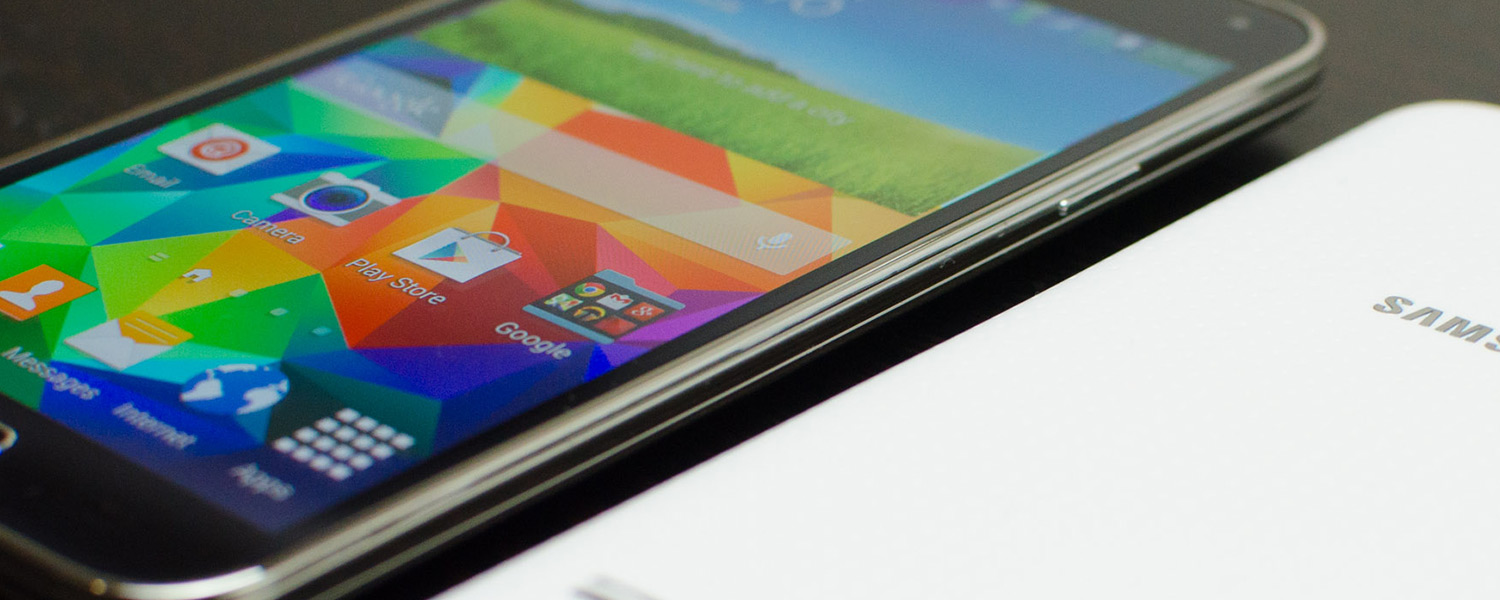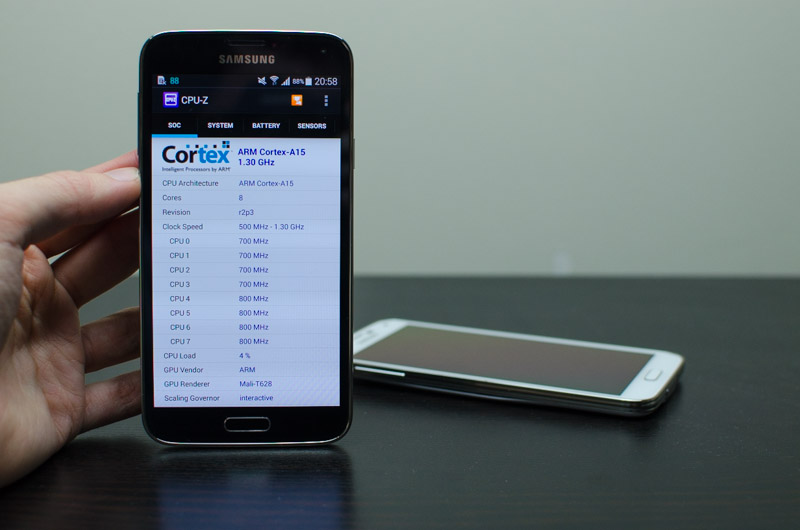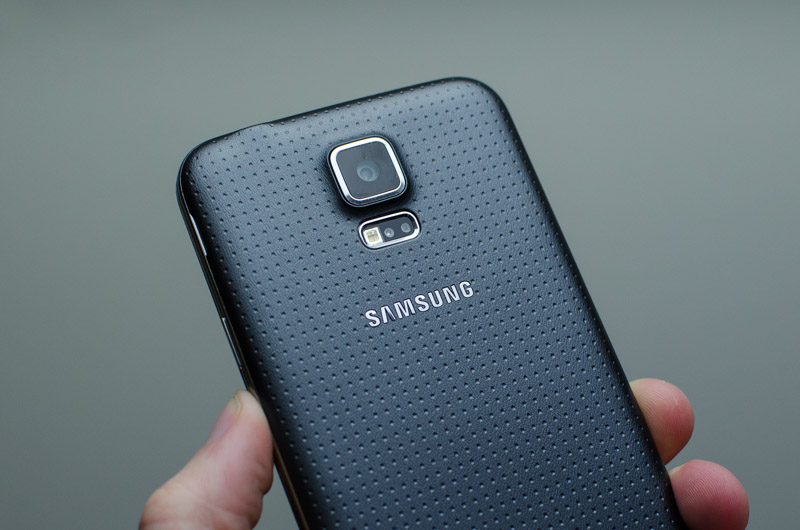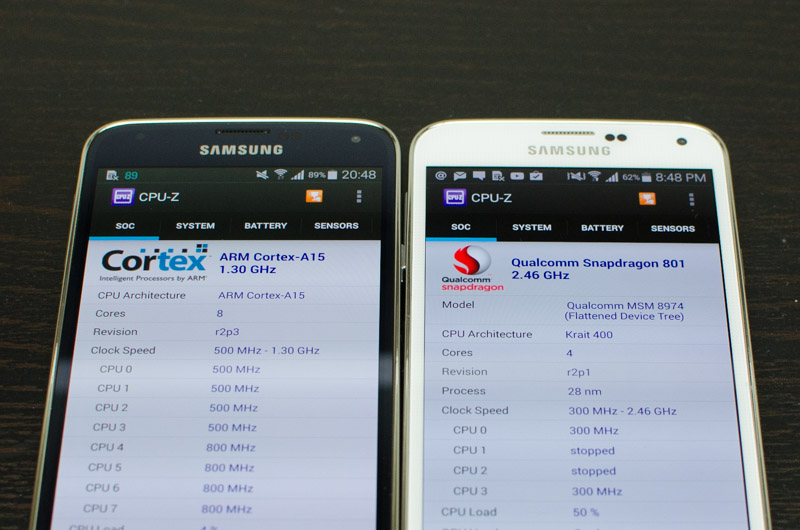Back in May I had the chance to review the Samsung Galaxy S5, and as expected it performed fantastically. The Qualcomm Snapdragon 801 SoC is one of the fastest smartphone chips out there, and its inclusion in the Galaxy S5 G900F allows it to easily power through any task.
However, the G900F isn't the only Galaxy S5 model available. Like with previous high-end Samsung smartphones - including the Galaxy S4, Galaxy S3 and Galaxy Note 3 - the company has released an Exynos-powered model alongside a Snapdragon-powered model. The Exynos Galaxy S5 is known as the G900H, in keeping with the standard nomenclature for S5 SKUs.
The G900H is typically sold in regions where 4G LTE networks aren't as prevalent, such as Latin America, Africa and the Middle East (which is where the model for this review was sourced). This is likely because the Exynos model costs less to produce than the Snapdragon-equipped version and that makes it a more affordable option for buyers in these markets.
Despite not being available in the United States, it's still possible to import a Galaxy S5 G900H if you really want one. Our friends at Expansys will sell you one for $50 less than the Snapdragon-powered G900F, which is a good deal if you're in the market for an unlocked high-end handset.
Want an even further discount? Just for TechSpot readers, Expansys is offering US$25 off all Galaxy S5 products until the end of July by entering the code S5-JUL-25US during checkout!
But before you go ahead and make a purchase, it's worth reading on to discover how the Exynos Galaxy S5 stacks up against the Snapdragon Galaxy S5. With previous Galaxy releases I've checked out both versions, and the Exynos model never stacked up from a performance or feature standpoint. However with the Galaxy S5, it looks like Samsung has closed the gap further between the two models, making the Exynos variant more attractive than ever.
G900F vs G900H: The Main Differences
The majority of the hardware found in both versions of the Galaxy S5 is identical. Both have the same 5.1-inch Super AMOLED display with a resolution of 1920 x 1080; both come with a 16-megapixel rear camera capable of 4K video recording; both devices have up to 32 GB of internal storage plus a microSD card slot; and both have a 2,800 mAh, 10.78 Wh removable battery.
Previous Galaxy devices had some slight differences in image quality between the Exynos and Snapdragon models, but that's not the case with the S5. Unlike with the Note 3, the Exynos Galaxy S5 is capable of 4K Ultra HD video recording, a first for Samsung's in-house SoC.
It goes without saying that the two versions feature the same external design design, both certified for IP67 water resistance. In fact, if I hadn't received a black G900H I probably wouldn't be able to tell it apart from the white G900F I already had.
Samsung's Exynos 5 Octa 5422 SoC pairs four ARM Cortex-A15 CPU cores, clocked at 1.9 GHz, with four ARM Cortex-A7 CPU cores clocked at 1.3 GHz. On the GPU side, there's a Mali T628MP6 clocked at under 695 MHz, and we also get a 32-bit dual-channel LPDDR3 memory controller providing 14.9 GB/s of bandwidth to 2 GB of RAM.
If you take a look at the spec sheet for the Exynos 5 Octa 5422, you'll notice the maximum clock speeds are rated at 2.1 GHz for the Cortex-A15 cluster and 1.5 GHz for the A7 cluster. For whatever reason - it likely has to do with battery life and heat output - Samsung has decided to run each unit at the same clock speeds as we saw in the Exynos Galaxy Note 3, which packed an Exynos 5 Octa 5420. I suspect the GPU is also downclocked to below the rated 695 MHz.
The inclusion of two quad-core CPU units is due to the implementation of ARM's big.LITTLE heterogeneous architecture that uses the more powerful, energy-hungry "big" A15 cores when tasks demand high levels of performance, while the "LITTLE" A7 cores are saved for low-power tasks. The CPU scheduler manages which tasks are allocated to which cores and when.
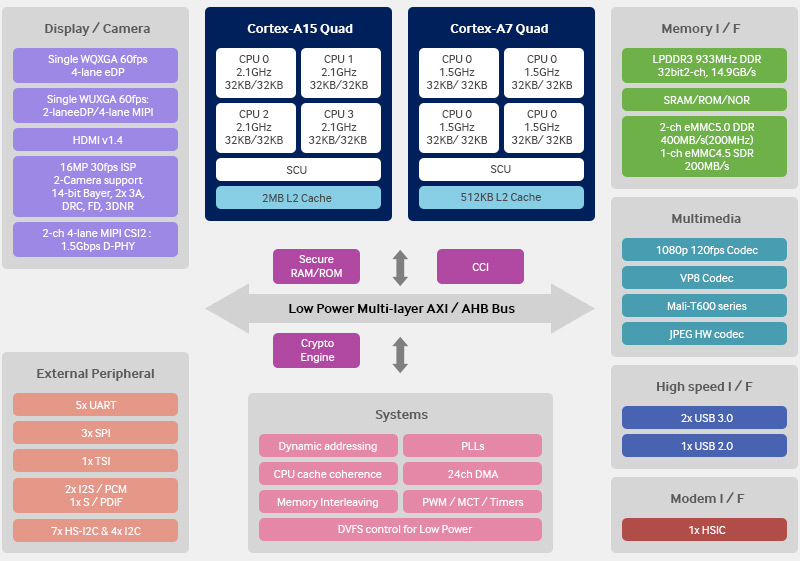
Unlike previous iterations of the Exynos 5 Octa, the 5422 supports heterogeneous multi-processing (HMP) with global task scheduling and it appears as though Samsung has enabled it. This means that all eight cores can be used simultaneously, instead of needing to migrate between clusters, which should result in improved performance and no stutter to speak of.
I'm hoping for a greater level of efficiency as well, equalling longer battery life, but there are no guarantees. The Exynos Galaxy Note 3 couldn't match the Snapdragon variant on battery life, so hopefully it's a little closer this time around.
Aside from the differences in CPU and GPU performance, the Exynos 5 Octa doesn't come with an integrated cellular radio, and Samsung hasn't paired it with an LTE-capable modem. The maximum download and upload speeds you can expect from the G900H are 42.2 Mbps and 4.76 Mbps respectively, a far cry from the 150/50 Mbps over LTE that the Snapdragon 801 supports.
Both the G900F and G900H support HSPA+ on the 850, 900, 1900 and 2100 MHz 3G bands, so there's no advantage to getting the G900H from a cellular perspective if you're in a 3G-only area. Some variants of the G900F will add the 1700 MHz band for North American networks, or even remove the 900 MHz band, so I'd advise checking with your local carrier before buying.
In short, a lack of LTE is the only main difference in connectivity between the Galaxy S5 SKUs: the G900H still packs Wi-Fi 802.11a/b/g/n/ac, Bluetooth 4.0, NFC, USB 3.0, infrared and GNSS. A full chart comparing both models can be found below.
| Specs | Galaxy S5 G900F | Galaxy S5 G900H |
| SoC | Snapdragon 801 MSM8974AC | Exynos 5 Octa 5422 |
| CPU | 4x Krait 400 @ 2.45 GHz | 4x ARM Cortex-A15 @ 1.9 GHz + 4x ARM Cortex-A17 @ 1.3 GHz |
| GPU | Adreno 330 @ 578 MHz | ARM Mali-T628 @ ~695 MHz |
| Memory |
2 GB dual-channel LPDDR3 @ 933 MHz |
|
| Storage | 16/32 GB internal + microSD | |
| Wi-Fi | 802.11 a/b/g/n/ac | |
| Bluetooth | 4.0 | |
| LTE | Category 4 | None |
| Other | NFC, Infrared LED, MHL, GPS, HSPA+, 2G | |
| Display | 5.1" 1080p Super AMOLED | |
| Battery | 10.78 Wh (2,800 mAh) | |
| Camera | 16 MP 1/2.6" sensor with f/2.2 lens | |
